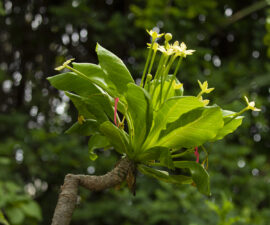Species May No Longer Exist in the Wild, But Zoo Breeding Programs Offer Hope
The rare Panamanian golden frog, a species endemic to Panama, is now breeding successfully at the San Diego Zoo’s Klauber-Shaw Reptile House. The species has been protected for more than 50 years and is treasured in Panama, much like the bald eagle is in the United States. But although the frog is listed as critically endangered, the species has not been seen in the wild for eight years, and it is believed to no longer exist in its native habitat.
The San Diego Zoo has been breeding Panamanian golden frogs for more than 10 years, and is one of a handful of accredited zoos successfully breeding this unique frog. The Zoo is currently home to five breeding individuals, which have produced more than 60 offspring. Since 2003, the Zoo has hatched more than 500 frogs in an off-exhibit breeding center.
“These frogs are critically important because not only are they are a national treasure to the people of Panama, but they—as well as many other species of amphibians—are on the verge of extinction unless we do something to help,” said Dave Grubaugh, senior keeper. “Frogs are important consumers of insects, which spread disease and destroy crops. They are also key to warning people to environmental problems, such as water pollution.”
Aside from their striking yellow and black coloration, Panamanian golden frogs are unique for many other reasons. As in many species, bright coloration is an indicator of toxicity. The skin of the Panamanian golden frog is highly poisonous, containing a nerve toxin called zetekitoxin (after the frog’s scientific name, Atelopus zeteki). The powerful toxin is a useful deterrent against predators. Native people have also used the frog’s toxic skin for centuries to tip their arrows with poison. The Panamanian golden frog also displays a unique behavior to communicate: a form of sign language. The frogs attract attention by lifting an arm in what looks like a waving motion, flagging down potential mates, as well as claiming territory or simply greeting other frogs.
Water pollution, pet trade collection, habitat loss and other human activities have decimated the Panamanian golden frog population, but perhaps the greatest threat is the deadly chytrid fungus. Chytrid fungus is a serious threat to thousands of frog species around the world. It is thought to be responsible for the extinction of more than 100 amphibian species, and it continues to threaten many more with extinction. There are no immediate plans to reintroduce Panamanian golden frogs into the wild, because the chytrid fungus is still present and other conditions remain unfavorable for survival. However, the hope is to eventually release the frogs back into their native habitat.





